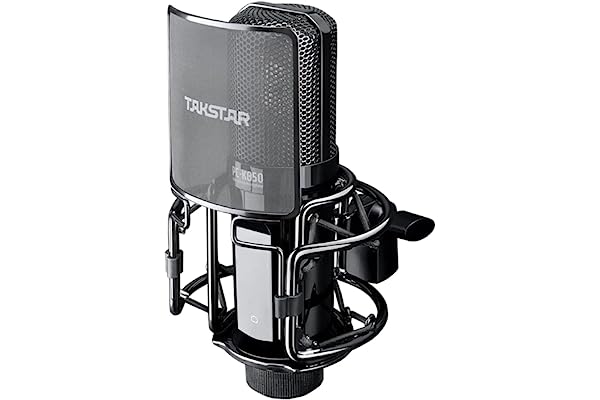Features
RØDE NT1

- Groundbreaking studio condenser microphone that fuses the classic sound signature of the iconic NT1 with patented next-generation technology
- Connect to an audio interface or mixer via XLR, or plug directly into a computer via USB to record studio-grade sound in any setup – an all-in-one digital recording solution for the home or the studio
- Offers the classic warm, silky character, extremely low self-noise and high SPL handling capability that the original is revered for, perfect for a huge range of applications, from voiceovers and guitars to drums and piano
- Features RØDE’s ultra-low-noise, high-gain Revolution Preamp and high-resolution (up to 192kHz) analog-to-digital conversion for crystal-clear digital recordings
- Body machined from high-grade aluminium with nickel plating and military-grade ceramic coating, ensuring its ready to take on the rigours of recording day in, day out
TAKSTAR PC-K850

- -Φ34mm large gold plated diaphragm capsule, wide frequency response, wide dynamic, clear and natural sound quality.
- -Adopts low background noise audio processing circuit to meet the high demand of recording requirement.
- -High sensitivity design for rich sound details pickup and original sound reproduction.
- -Prominent SPL performance effectively prevents from overload distortion.
- -Provided with metal shock mount. Provided with aluminum carrying case for convenient transportation and storage.
Introduction
Are you looking for a great microphone to take your music production, vocal recordings, and podcasting to the next level? If so, you may be considering the RØDE NT1 5th Generation Large-Diaphragm Studio Condenser Microphone with XLR and USB Outputs, Shock Mount, and Pop Filter, or the TAKSTAR XLR Condenser Microphone with 34mm Large Diaphragm, High Sensitivity Cardioid Studio Mic for Recording, Podcasting, Streaming, Voice Overs, YouTube Videos, and Gaming (PC-K850).
Both microphones are high-quality and offer excellent features, but which one is right for you? In this blog post, we’ll compare the two products side-by-side, exploring their differences and similarities. We’ll also provide you with the information you need to make an informed decision so that you can choose the perfect microphone for your needs.
Design and Build Quality
The RØDE NT1 is a large-diaphragm condenser microphone with a sleek black finish. It has a solid build quality and is designed for durability. The microphone comes with a shock mount and pop filter, as well as an XLR and USB output.
The TAKSTAR XLR Condenser Microphone is also a large-diaphragm condenser microphone, though it has a slightly different design. It has a high-sensitivity cardioid studio mic and comes with a 34mm large diaphragm. It is also designed for durability and comes with a high-quality XLR output.
Both microphones have similar design and build quality, though the RØDE NT1 has the added bonus of the USB output.
Audio Quality
The RØDE NT1 offers excellent audio quality with its large-diaphragm condenser microphone. It has a wide frequency response and low noise floor, making it ideal for recording vocals and instruments. It also has a built-in pop filter and shock mount for added protection.
The TAKSTAR XLR Condenser Microphone also has a large diaphragm and offers excellent audio quality. It has a high-sensitivity cardioid studio mic and a 34mm large diaphragm, making it ideal for recording vocals and instruments. It also has a built-in pop filter and shock mount for added protection.
Both microphones offer excellent audio quality, though the RØDE NT1 has the added benefit of the USB output.
Price
The RØDE NT1 is priced at around $300, making it a more expensive option than the TAKSTAR XLR Condenser Microphone, which is priced at around $150.
Conclusion
The RØDE NT1 5th Generation Large-Diaphragm Studio Condenser Microphone and the TAKSTAR XLR Condenser Microphone both offer excellent features and audio quality. The RØDE NT1 is more expensive but has the added bonus of the USB output, while the TAKSTAR XLR Condenser Microphone is more affordable. Ultimately, the choice is up to you and your needs.
We hope this blog post has helped you make an informed decision on which microphone is right for you. For more information, be sure to check out the official websites of both products:
RØDE NT1 5th Generation Large-Diaphragm Studio Condenser Microphone
TAKSTAR XLR Condenser Microphone
Specifications / Attributes
| Feature | RØDE NT1 | TAKSTAR PC-K850 |
|---|---|---|
| Batteries Included | N/A | No |
| Batteries Required | N/A | No |
| Brand | N/A | Takstar |
| Colour | Black | N/A |
| Compatible Devices | Laptop, Personal Computer | pc-k850 |
| Connector | USB, XLR Connector | N/A |
| Connector Type | N/A | XLR |
| Date First Available | 21 February 2023 | 22 November 2021 |
| Hardware Platform | Laptop | PC |
| Item Model Number | NT1 5th Gen | KJYPMKF00447 |
| Item Weight | 308 g | 420 g |
| Manufacturer | N/A | PC-K850 |
| Material Type | N/A | Aluminium |
| Microphone format | N/A | Large Diaphragm |
| Model | N/A | KJYPMKF00447 |
| Mounting Hardware | N/A | microphone |
| Noise level | N/A | 130 dB |
| Package Dimensions | N/A | 25.3 x 24.69 x 13.89 cm; 420 Grams |
| Part Number | N/A | KJYPMKF00447 |
| Power Source | Corded Electric | Corded Electric |
| Product dimensions | 27.18 x 20.96 x 17.65 cm; 308 Grams | N/A |
| Signal-to-noise ratio (dB) | N/A | 130 dB |
| Check the Best Deal Price Today | Check the Best Deal Price Today |







